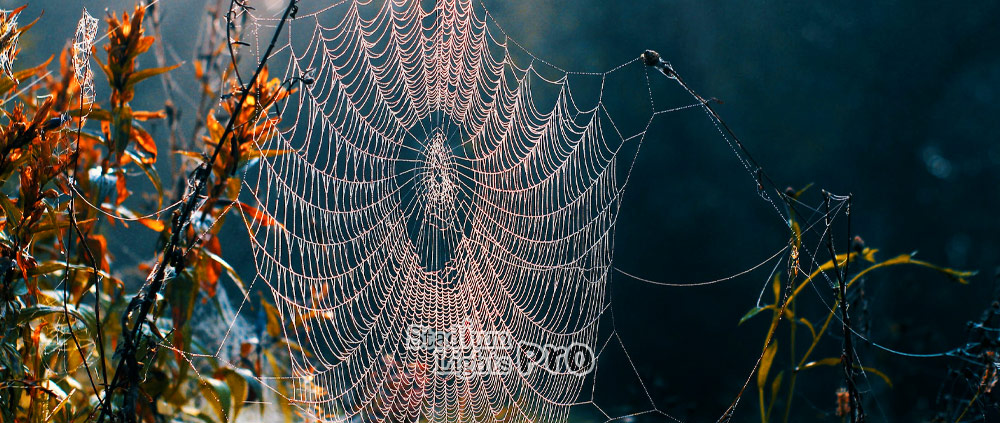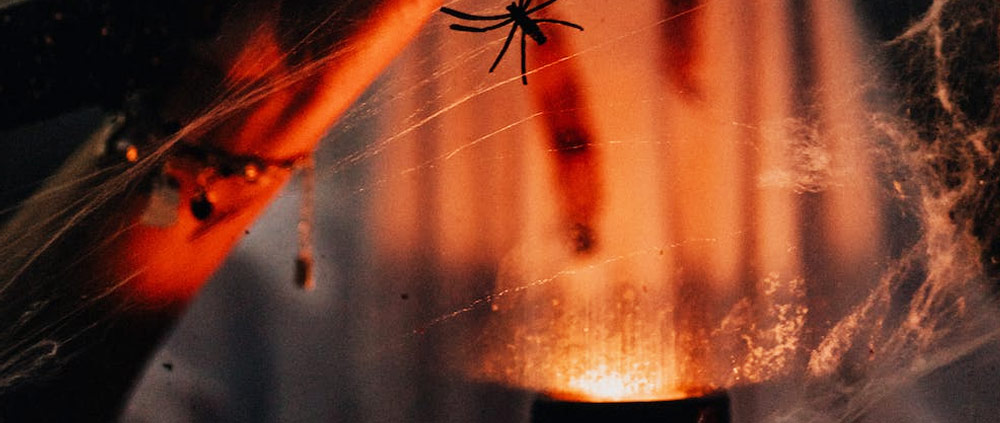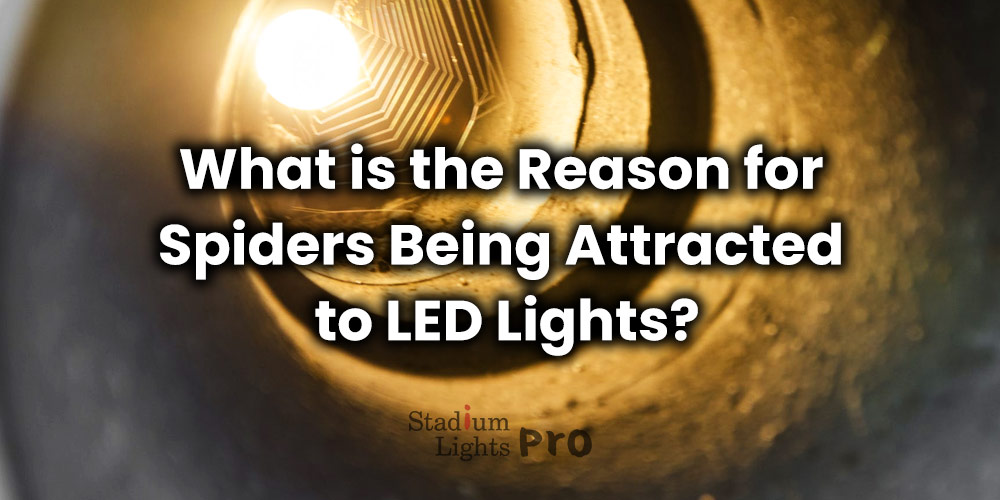LED lights have been found to attract spiders, leading to an intriguing and somewhat puzzling phenomenon. Spiders, often associated with dark and secluded spaces, seem to be drawn towards the bright and energy-efficient glow of LED lights. This behavior has been observed in various settings, both indoor and outdoor, raising questions about the factors influencing spiders’ attraction to this specific type of lighting.
The phenomenon manifests as spiders building webs or congregating near LED light sources. This behavior is particularly noticeable at night when these lights are more prominent. The reasons behind this attraction are not entirely clear, but several factors, such as light intensity, color temperature, and even the flickering of LED lights, may contribute to this intriguing interaction between spiders and artificial illumination.
Table of Contents
ToggleImportance of Understanding Why LED Lights Attract Spiders
Impact on Indoor Environments
Given the widespread use of LED lights in homes and commercial spaces, understanding why spiders are attracted to these lights is crucial for indoor environmental management. Homeowners may experience increased spider activity around light fixtures, affecting both aesthetics and comfort.
Potential Ecological Consequences
The phenomenon could have ecological implications, especially in outdoor environments where LED streetlights are commonly used. Changes in spider behavior may influence local ecosystems, affecting the balance of insect populations and potentially impacting other species in the food chain.
Relevance to Human Well-being and Safety
Spiders congregating around LED lights may create safety concerns, especially in outdoor areas where people gather. Understanding this behavior is essential for developing strategies to minimize the presence of spiders in spaces where their proximity to humans may lead to discomfort or fear.
The Science Behind LED Lights and Spider Attraction

LED lights, characterized by their energy efficiency and diverse applications, play a unique role in the interaction between spiders and artificial illumination. To comprehend this phenomenon, it is essential to explore the intrinsic characteristics of LED lights.
An overview of LED light characteristics reveals that these lights emit a specific spectrum of wavelengths. Unlike traditional incandescent bulbs, which produce a broader spectrum, LED lights tend to have a more focused emission. This spectral specificity becomes a critical factor in understanding their influence on spider behavior.
Spider vision, though differing from human eyesight, is highly adapted to certain wavelengths of light. Spiders are known to be sensitive to ultraviolet (UV) and polarized light, which are crucial for various aspects of their biology, including hunting and communication. The intricacies of spider vision, therefore, become a pivotal component in unraveling why LED lights attract spiders.
The interaction between spiders and the LED light spectrum involves the nuanced response of these arachnids to the emitted wavelengths. Research suggests that spiders may perceive LED lights as suitable environments for hunting or web-building due to the specific wavelengths produced. The attraction might be linked to the perception of LED light as a favorable setting for prey capture or mate attraction.
As we delve into the convergence of LED light characteristics and spider vision, a deeper comprehension emerges regarding the mechanisms that drive spiders toward these artificial light sources. This exploration paves the way for a more holistic understanding of the intricate relationship between spiders and the modern lighting technologies that define our illuminated spaces.
Factors Influencing Spider Attraction to LED Lights
The attraction of spiders to LED lights is a multifaceted phenomenon influenced by several key factors, each contributing to the intriguing interplay between arachnids and modern illumination.
Light Intensity and Brightness
The intensity and brightness of LED lights emerge as pivotal elements shaping spider behavior in proximity to artificial illumination. Research suggests that spiders are drawn to light sources with higher intensity, potentially associating them with enhanced hunting grounds or suitable locations for web construction. Understanding the correlation between light intensity and spider attraction provides valuable insights into mitigating or manipulating this behavior in different settings.
Color Temperature of LED Lights
The color temperature of LED lights, measured in Kelvin, plays a crucial role in spider attraction. Spiders often exhibit preferences for specific wavelengths, and the color temperature of LED lights can influence their perception. Certain color temperatures may mimic natural lighting conditions that spiders associate with optimal hunting environments. Investigating how color temperature affects spider behavior sheds light on the nuanced aspects of their visual perception and the factors driving them towards LED light sources.
Impact of LED Light Flickering
The phenomenon of LED light flickering introduces another dimension to the interaction between spiders and artificial illumination. Some LED lights exhibit subtle flickering, which may go unnoticed by human observers but can have a significant impact on spider behavior. Research suggests that flickering lights might attract spiders more effectively than steady illumination. Examining the implications of LED light flickering provides valuable information for designing lighting systems that minimize unintended spider attraction, especially in outdoor or public spaces.
By scrutinizing these factors – light intensity, color temperature, and flickering – we gain a comprehensive understanding of the variables influencing spider attraction to LED lights. This knowledge serves as a foundation for developing strategies to manage and control spider presence in various environments where artificial lighting is prevalent.
Ecological Implications
Potential Effects on Spider Behavior and Natural Ecosystems

The attraction of spiders to LED lights carries implications for both their individual behavior and broader ecological dynamics. As spiders gravitate towards artificial illumination, there is a potential disruption in their natural behavioral patterns. This altered behavior may impact various aspects of spider life, including hunting strategies, mating rituals, and web-building activities. Understanding these behavioral shifts is crucial for gauging the overall health and functioning of natural ecosystems where spiders play a significant ecological role.
Moreover, the increased concentration of spiders around LED lights may lead to imbalances in local insect populations. Spiders are natural predators of insects, and their congregation in specific areas influenced by artificial lighting might result in a skewed predation dynamic. This has the potential to affect the abundance and diversity of insects, subsequently influencing the broader ecosystem. The cascading effects of changes in spider behavior can have repercussions throughout the food chain, making it essential to assess and comprehend these potential ecological consequences.
Role of LED Lights in Altering Spider Distribution
The widespread use of LED lights, especially in urban and suburban environments, introduces a novel factor influencing spider distribution. Artificial illumination can act as a catalyst in shaping the geographical spread of spider populations. Spiders may be drawn to illuminated areas, leading to a concentration of their presence in urbanized regions. This altered distribution may have consequences for local biodiversity, as certain spider species become more prevalent in areas with high artificial lighting.
Human Perspectives and Concerns
Impact on Indoor Spaces and Homes
The phenomenon of spiders being attracted to LED lights holds practical implications for indoor environments, raising concerns among homeowners and occupants. As LED lights become commonplace in residential settings, the increased presence of spiders around these sources of illumination can impact the overall ambiance and comfort within homes. Residents may find the unwarranted congregation of spiders near light fixtures disconcerting, leading to a need for effective strategies to manage this phenomenon.
Furthermore, the potential intrusion of spiders into indoor spaces can pose challenges for those with arachnophobia or general discomfort with spiders. Understanding the impact on human well-being and the indoor living experience is essential for addressing the coexistence of spiders and LED lights within the confines of homes.
Mitigation Strategies for Reducing Spider Attraction
Developing effective mitigation strategies becomes imperative in managing the attraction of spiders to LED lights, particularly in areas where human comfort is a priority. Some potential strategies include adjusting lighting conditions to make the environment less appealing to spiders. This may involve,
- Optimizing Light Intensity – Fine-tuning the intensity of LED lights to levels that are sufficient for human needs but less attractive to spiders.
- Utilizing Specific Color Temperatures – Choosing LED lights with color temperatures less likely to attract spiders based on their known preferences for certain wavelengths.
- Minimizing Flickering – Implementing LED lighting systems that minimize flickering, as some studies suggest that steady illumination may be less appealing to spiders.
- Strategic Placement – Considering the strategic placement of lighting fixtures to deter spiders from congregating in high-traffic or critical areas within homes.
By implementing these mitigation strategies, homeowners and occupants can create environments that balance human comfort with effective measures to reduce the unwanted presence of spiders attracted to LED lights. Finding this equilibrium is essential for promoting a harmonious living space while acknowledging the intricacies of the natural behaviors of these arachnids.
Future Research and Recommendations
Areas for Further Investigation
Specific Wavelength Preferences
Further research is needed to pinpoint the specific wavelengths of LED light that are most attractive to spiders. Understanding the nuances of their visual preferences can inform the development of lighting solutions that are less enticing to arachnids.
Behavioral Responses
Investigating the detailed behavioral responses of spiders to different light conditions, including variations in intensity, color temperature, and flickering patterns. This can provide insights into the underlying mechanisms driving their attraction and aid in the development of targeted mitigation strategies.
Impact on Different Spider Species
Examining how various spider species respond to LED lights can contribute to a more comprehensive understanding of this phenomenon. Different species may exhibit distinct preferences or sensitivities, influencing their interaction with artificial lighting in diverse ways.
Long-Term Ecological Consequences
Assessing the long-term ecological consequences of increased spider attraction to LED lights, including potential effects on insect populations, ecosystem dynamics, and overall biodiversity. This research can guide conservation efforts and urban planning strategies.
Suggestions for Minimizing Spider Attraction to LED Lights
Research-Informed Lighting Design
Designing LED lighting systems based on the findings of research into spider preferences and behavior. This may involve creating lighting with specific spectral characteristics that are less appealing to spiders while still meeting human lighting needs.
Adjustable Lighting Parameters
Developing LED lights with adjustable parameters, allowing users to customize light intensity and color temperature based on their preferences. This flexibility can help individuals tailor lighting conditions to minimize spider attraction in specific contexts.
Innovative Light Filters
Exploring the development of light filters or coatings that can be applied to LED fixtures, altering the spectral output in ways that deter spiders without compromising human visual comfort.
Public Awareness and Education
Raising awareness among the public about the connection between LED lights and spider attraction. Educating individuals about the factors influencing this phenomenon and providing guidance on mitigating strategies can contribute to a more informed and proactive approach to managing spider presence in various settings.
Conclusion
In unraveling the enigma of spiders’ attraction to LED lights, our exploration has unveiled a complex interplay between the characteristics of artificial illumination and the intricacies of arachnid behavior. This phenomenon, observed in both indoor and outdoor settings, has far-reaching implications for diverse aspects of our lives and the ecosystems we inhabit.
From the captivating science behind LED lights and spider interaction to the ecological consequences of altered behavior, it is evident that this seemingly niche topic extends into broader considerations. The impact on indoor spaces raises questions about the delicate balance between human comfort and the cohabitation with spiders. In outdoor environments, the alteration of spider distribution prompts reflections on urban planning and the unintended consequences of modern lighting technologies on local biodiversity.
The practical concerns for homeowners and the potential for mitigating strategies underscore the need for further research and informed recommendations. As we peer into the future, understanding specific spider preferences, behavioral nuances, and the long-term ecological consequences of this attraction becomes paramount. By leveraging this knowledge, we can craft lighting solutions that harmonize with both human needs and the natural behaviors of spiders.
The fascination of spiders with LED lights serves as more than a curious observation—it beckons us to explore the intricate connections between technology, nature, and the spaces we inhabit. As we continue to illuminate the path forward, a thoughtful balance can be struck, ensuring that the brilliance of modern lighting coexists seamlessly with the delicate rhythms of the arachnid world.

